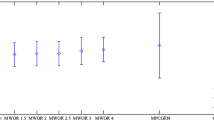Abstract
Metamorphic malware is capable of changing its internal structure without altering its functionality. A common signature is nonexistent in highly metamorphic malware and, consequently, such malware can remain undetected under standard signature scanning. In this paper, we apply previous work on structural entropy to the metamorphic detection problem. This technique relies on an analysis of variations in the complexity of data within a file. The process consists of two stages, namely, file segmentation and sequence comparison. In the segmentation stage, we use entropy measurements and wavelet analysis to segment files. The second stage measures the similarity of file pairs by computing an edit distance between the sequences of segments obtained in the first stage. We apply this similarity measure to the metamorphic detection problem and show that we obtain strong results in certain challenging cases.


















Similar content being viewed by others
References
Addison, P.: The Illustrated Wavelet Transform Handbook: Introductory Theory and Applications in Science. Engineering, Medicine and Finance. Taylor and Francis Group, New York (2002)
Apostolico, A., Galil, Z.: Pattern Matching Algorithms. Oxford University Press, Oxford (1997)
Attaluri, S., McGhee, S., Stamp, M.: Profile hidden Markov models and metamorphic virus detection. J. Comput. Virol. 5(2), 151–169 (2009)
Aycock, J.: Computer Viruses and Malware. Springer, New York (2006)
Baysa, D.: Structural entropy and metamorphic malware. Master’s report, Department of Computer Science, San Jose State University. http://scholarworks.sjsu.edu/etd_projects/283/ (2012)
Borda, M.: Fundamentals in Information Theory and Coding. Springer, New York (2011)
Borello, J., Me, L.: Code obfuscation techniques for metamorphic viruses. J. Comput. Virol. 4(3), 30–40 (2008)
Bradley, A.P.: The use of the area under the ROC curve in the evaluation of machine learning algorithms. Pattern Recognit. 30, 1145–1159 (1997)
Burford, S.: Reverse engineering Linux ELF binaries on the x86 platform. http://www.linuxsa.org.au/meetings/reveng-0.2.pdf (2002)
Cilibrasi, R., Vitányi, P.M.B.: Clustering by compression. IEEE Trans. Inform. Theory 51(4), 1523–1545 (2005)
Collberg, C., Thomborson, C., Low, C.: A taxonomy of obfuscating transformations. Technical Report #118. The University of Auckland (1997)
Cygwin, Cygwin utility files. http://www.cygwin.com/. Accessed Dec 2012
Islita, M.: Levenshtein edit distance. http://www.miislita.com/searchito/levenshtein-edit-distance.html (2006)
Karmeshu.: Entropy Measures, Maximum Entropy Principle and Emerging Applications. Springer, New York (2003)
The Mental Driller, Metamorphism in practice or “How I made MetaPHOR and what I’ve learnt”. http://biblio.l0t3k.net/magazine/en/29a/ (2002)
Patel, M.: Similarity tests for metamorphic virus detection, Master’s report. Department of Computer Science, San Jose State University. http://scholarworks.sjsu.edu/etd_projects/175/ (2011)
Pietrek, M.: Peering inside the PE: a tour of the Win32 portable executable file format. MSDN Magazine. http://msdn.microsoft.com/en-us/magazine/ms809762.aspx (1994)
Radhakrishnan, D.: Approximate disassembly, Master’s report. Department of Computer Science, San Jose State University. http://scholarworks.sjsu.edu/etd_projects/155/ (2010)
Robinson, S.: Expert. NET 1.1 Programming. Apress, New York (2004)
Runwal, N., Low, R., Stamp, M.: Opcode graph similarity and metamorphic detection. J. Comput Virol. 8(1–2), 37–52 (2012)
SearchSecurity, Metamorphic and polymorphic malw- are. http://searchsecurity.techtarget.com/definition/metamorphic-and-polymorphic-malware (2010)
Shah, A.: Approximate disassembly using dynamic programming, Master’s report. Department of Computer Science, San Jose State University. http://scholarworks.sjsu.edu/etd_projects/8/ (2010)
Shanmugam, G., Low, R., Stamp, M.: Simple substitution distance and metamorphic detection. J. Comput. Virol. (to appear)
Snakebyte, Next Generation Virus Construction Kit (NGVCK). Open Malware http://www.offensivecomputing.net/ (2000)
Sorokin, I.: Comparing files using structural entropy. J. Comput. Virol. 7(4), 259–265 (2011)
Sridhara, S.M., Stamp, M.: Metamorphic worm that carries its own morphing engine. J. Comput. Virol. (2012) (online \(\text{ first }^{\rm TM}\))
Stamp, M.: A revealing introduction to hidden Markov models. http://cs.sjsu.edu/~stamp/RUA/HMM.pdf (2012)
Struzik, Z., Siebes, A.: The Haar wavelet transform in the time series similarity paradigm. In: Proceedings of the Third European Conference on Principles of Data Mining and Knowledge Discovery (PKDD ’99). Springer, London. http://dl.acm.org/citation.cfm?id=669368 (1999)
Symantec, Viruses, worms, and trojans. http://service1.symantec.com/support/nav.nsf/docid/1999041209131106 (2011)
Van Fleet, P.: The discrete haar wavelet transformation. Joint Mathematical Meetings, Center for Applied Mathematics, University of St. Thomas. http://cam.mathlab.stthomas.edu/wavelets/pdffiles/NewOrleans07/HaarTransform.pdf (2007)
Verschuuren, G.: Excel 2007 for Scientists and Engineers. Holy Macro! Books (2008)
Virus files, Department of Computer Science, San Jose State University. http://cs.sjsu.edu/~stamp/viruses/ (2012)
Vuorenmaa, T.: The discrete wavelet transform with financial time series applications. Seminar on Learning Systems, University of Helsinki. http://www.rni.helsinki.fi/teaching/sols/TV_RNI.pdf (2003)
Wagner, R.A., Fischer, M.J.: The string-to-string correction problem. J. ACM (JACM) 21(1), 168–173 (1974)
Wong, W., Stamp, M.: Hunting for metamorphic engines. J. Comput. Virol. 2(3), 211–229 (2006)
You, I., Yim, K.: Malware obfuscation techniques: a brief survey. In: International Conference on Broadband, Wireless Computing. Communication and Applications (BWCCA), pp. 297–300 (2010)
Author information
Authors and Affiliations
Corresponding author
Rights and permissions
About this article
Cite this article
Baysa, D., Low, R.M. & Stamp, M. Structural entropy and metamorphic malware. J Comput Virol Hack Tech 9, 179–192 (2013). https://doi.org/10.1007/s11416-013-0185-4
Received:
Accepted:
Published:
Issue Date:
DOI: https://doi.org/10.1007/s11416-013-0185-4




